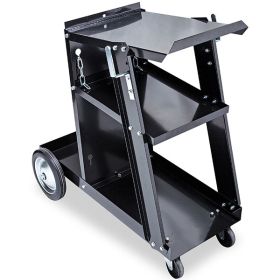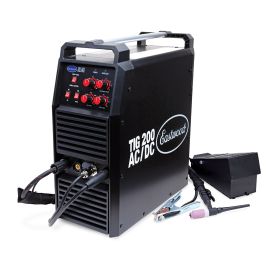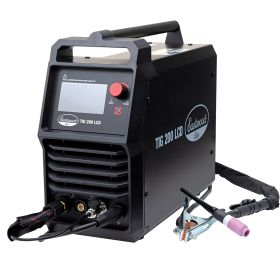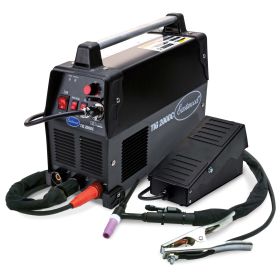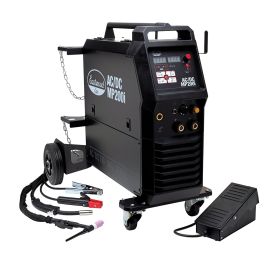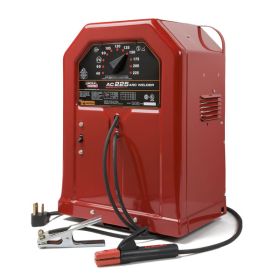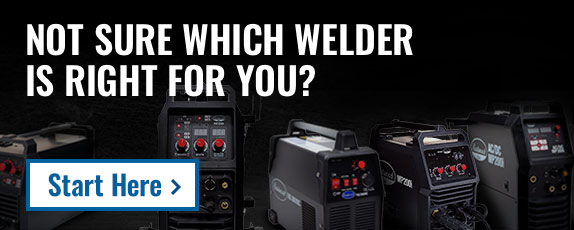
TIG, Stick, & Arc Welders
TIG (Tungsten Inert Gas) welding uses a non-consumable tungsten electrode to create the weld. A separate filler metal is typically added manually to the weld pool. The weld area is shielded from atmospheric contamination by an inert gas, typically argon or helium.
TIG welders produce high-quality, precise welds and are commonly used in industries where weld quality is critical, such as aerospace, nuclear, and pharmaceutical industries. They are suitable for welding thin materials and exotic metals like titanium and magnesium.
Stick welding, also known as shielded metal arc welding (SMAW), uses a consumable electrode coated in flux. When the electrode is struck against the workpiece, an arc is formed, melting both the electrode and the base metal to create the weld.
Stick welders are versatile and can be used for welding a wide range of metals, including steel, stainless steel, cast iron, and some non-ferrous metals. They are commonly used in construction, maintenance, and repair applications, especially in outdoor and field welding where MIG or TIG welding may not be feasible.
Arc welding is a broad term that encompasses several welding processes, including stick welding, MIG welding, and TIG welding. Essentially, arc welding involves using an electric arc to melt and fuse metal together.
TIG Welders
Initially developed to weld magnesium and aluminum in the aircraft industry in the 1930s, TIG welding has become an essential process for auto restorers and fabricators who do a lot of work with thinner-gauge metals, especially aluminum or chrome-moly steel. If you’re considering purchasing a TIG welder, but you’re not sure what exactly you need, we’re here to help you select the right machine for your job.
Eastwood offers the TIG 200 DC, the TIG 200 AC/DC and the LCD Digital TIG 200 AC/DC welder for mechanics and bodyworkers. Each unit will weld steel up to ¼-inch thick and all come with a 3-year warranty from Eastwood against defects. Both AC/DC machines will also weld up to ¼-inch aluminum, a material seen much more on modern vehicles.
If MIG welding is like using a paint roller, then TIG welding is like using a small detail brush. It requires skill and technique. With it, you can work better with the types of thinner gauge materials and wider variety of metals you're likely to find in a restoration project. Additionally, TIG welding gives machinists the flexibility to realize some of their more creative visions.
Stick Welders
When stick welding is the best option for metal work, you can get the right equipment for less by shopping at Eastwood. Shielded metal arc welding, or stick welding, is often considered the most basic form of welding. But don’t confuse “basic” to mean you can use just any old stick welder on your project car. You still need a good arc welder to form a strong bond between metals. Find the right arc welder for sale at Eastwood that will create great welds on steel and iron, particularly with tubular steel structures such as roll bars.
Arc Welders
The experienced fabricators on Eastwood’s R&D team have created multiple arc welders for different applications. Our standard Arc 80 Stick Welder is a lightweight unit that is effective for thin steel and stainless steel. For additional power, get the Arc 200i Welder and its 200-amp max output.
These inverter units are valued for their portability as they can all be easily toted along for unexpected projects. Each one has a three-year manufacturer’s warranty and our 100 percent customer satisfaction guarantee. If you prefer a stick welder that uses AC current, consider the Lincoln Electric LEW K1170 that can operate at anywhere from 40 to 225 amps.
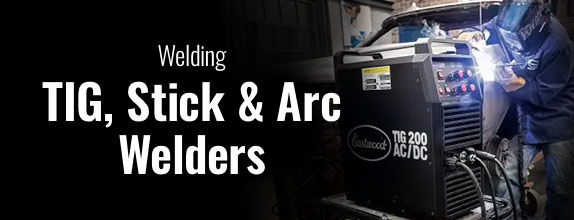


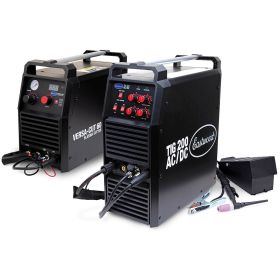 Eastwood 200 AMP TIG Welder and 60 Amp Versa-Cut Plasma Cutter ComboReg. $1,783.98 Sale $1,349.97 Save $434.01
Eastwood 200 AMP TIG Welder and 60 Amp Versa-Cut Plasma Cutter ComboReg. $1,783.98 Sale $1,349.97 Save $434.01
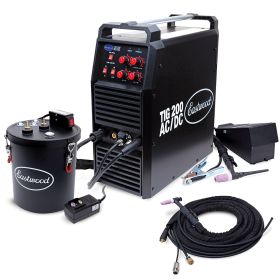 Eastwood TIG 200 AC/DC Welder with Water Cooler and WP18F TorchReg. $1,406.97 Sale $899.97 Save $507.00
Eastwood TIG 200 AC/DC Welder with Water Cooler and WP18F TorchReg. $1,406.97 Sale $899.97 Save $507.00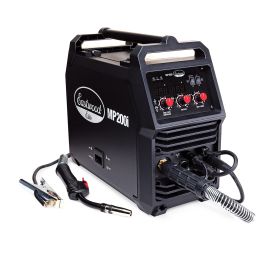 Eastwood 200 Amp Elite MP200i Multi Process Welder MIG - TIG - StickReg. $944.99 Sale $774.97 Save $170.02
Eastwood 200 Amp Elite MP200i Multi Process Welder MIG - TIG - StickReg. $944.99 Sale $774.97 Save $170.02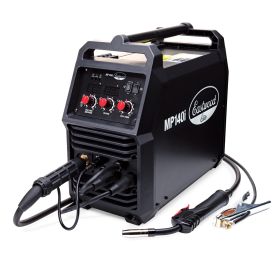 Eastwood 140 Amp Elite MP140i Multi Process Welder MIG - TIG -StickReg. $599.99 Sale $449.97 Save $150.02
Eastwood 140 Amp Elite MP140i Multi Process Welder MIG - TIG -StickReg. $599.99 Sale $449.97 Save $150.02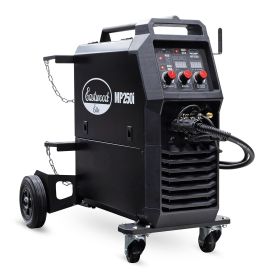 Eastwood MP250i Multi-Process 250 Amp Welder MIG - TIG - ARCReg. $1,599.99 Sale $1,299.97 Save $300.02
Eastwood MP250i Multi-Process 250 Amp Welder MIG - TIG - ARCReg. $1,599.99 Sale $1,299.97 Save $300.02
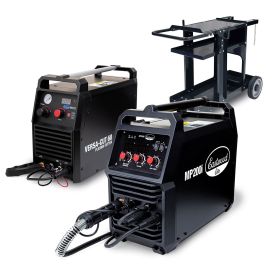 Eastwood 200 Amp Multi-Process Welder and 60 Amp Versa-Cut Plasma Cutter plus Welding CartReg. $1,954.97 Sale $1,499.97 Save $455.00
Eastwood 200 Amp Multi-Process Welder and 60 Amp Versa-Cut Plasma Cutter plus Welding CartReg. $1,954.97 Sale $1,499.97 Save $455.00


TIG, Stick, & Arc Welders
TIG (Tungsten Inert Gas) welding uses a non-consumable tungsten electrode to create the weld. A separate filler metal is typically added manually to the weld pool. The weld area is shielded from atmospheric contamination by an inert gas, typically argon or helium.
TIG welders produce high-quality, precise welds and are commonly used in industries where weld quality is critical, such as aerospace, nuclear, and pharmaceutical industries. They are suitable for welding thin materials and exotic metals like titanium and magnesium.
Stick welding, also known as shielded metal arc welding (SMAW), uses a consumable electrode coated in flux. When the electrode is struck against the workpiece, an arc is formed, melting both the electrode and the base metal to create the weld.
Stick welders are versatile and can be used for welding a wide range of metals, including steel, stainless steel, cast iron, and some non-ferrous metals. They are commonly used in construction, maintenance, and repair applications, especially in outdoor and field welding where MIG or TIG welding may not be feasible.
Arc welding is a broad term that encompasses several welding processes, including stick welding, MIG welding, and TIG welding. Essentially, arc welding involves using an electric arc to melt and fuse metal together.
TIG Welders
Initially developed to weld magnesium and aluminum in the aircraft industry in the 1930s, TIG welding has become an essential process for auto restorers and fabricators who do a lot of work with thinner-gauge metals, especially aluminum or chrome-moly steel. If you’re considering purchasing a TIG welder, but you’re not sure what exactly you need, we’re here to help you select the right machine for your job.
Eastwood offers the TIG 200 DC, the TIG 200 AC/DC and the LCD Digital TIG 200 AC/DC welder for mechanics and bodyworkers. Each unit will weld steel up to ¼-inch thick and all come with a 3-year warranty from Eastwood against defects. Both AC/DC machines will also weld up to ¼-inch aluminum, a material seen much more on modern vehicles.
If MIG welding is like using a paint roller, then TIG welding is like using a small detail brush. It requires skill and technique. With it, you can work better with the types of thinner gauge materials and wider variety of metals you're likely to find in a restoration project. Additionally, TIG welding gives machinists the flexibility to realize some of their more creative visions.
Stick Welders
When stick welding is the best option for metal work, you can get the right equipment for less by shopping at Eastwood. Shielded metal arc welding, or stick welding, is often considered the most basic form of welding. But don’t confuse “basic” to mean you can use just any old stick welder on your project car. You still need a good arc welder to form a strong bond between metals. Find the right arc welder for sale at Eastwood that will create great welds on steel and iron, particularly with tubular steel structures such as roll bars.
Arc Welders
The experienced fabricators on Eastwood’s R&D team have created multiple arc welders for different applications. Our standard Arc 80 Stick Welder is a lightweight unit that is effective for thin steel and stainless steel. For additional power, get the Arc 200i Welder and its 200-amp max output.
These inverter units are valued for their portability as they can all be easily toted along for unexpected projects. Each one has a three-year manufacturer’s warranty and our 100 percent customer satisfaction guarantee. If you prefer a stick welder that uses AC current, consider the Lincoln Electric LEW K1170 that can operate at anywhere from 40 to 225 amps.





